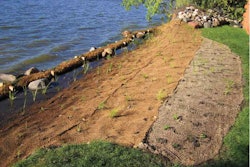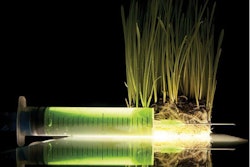Enhanced-efficiency fertilizers are proving their value in environmentally sensitive areas and beyond.
Maryland recently passed into law what some are calling one of the toughest measures in the country regulating the use of lawn fertilizer, limiting both the content and application of fertilizer for urban and suburban areas. With a precedent now in place, other states are looking to follow suit, and it could mean a whole new way of doing business for turf managers.
While the new law places limitations on traditional fertilizer use, it does make special allowances for coated fertilizer products. This has many lawncare professionals taking a serious look at controlled-release products as a way to save their business and stay in compliance with the new regulations.
Of note is the fact it was a lawncare professional who helped convince Maryland lawmakers that one blanket law for fertilizers would not accurately address the objective of decreasing excess nitrogen levels in turf. Ken Mays, president of Scientific Plant Service, a lawncare company that services Maryland, Pennsylvania and Virginia, lobbied the Chesapeake Bay Commission, presenting research demonstrating that controlled-release fertilizers provide nitrogen on an as-needed basis in turf.
Perhaps the most persuasive piece of research considered by the Commission was this: During the course of a year, if you use a product with a polymer coating (controlled release), you’ll end up applying up to 40 percent less nitrogen to turf compared to what you would with traditional products — getting fertilizer where it needs to be and, more importantly, preventing it from going where it shouldn’t.
Controlled release fertilizers can save time and money during the course of the year.While the outcome of the Maryland legislation was favorable for controlled-release fertilizers, manufacturers of coated products are gearing up to educate the market about the environmental benefits of using these products, especially now that fertilizer use in general has come under more scrutiny.
Pennsylvania is expected to be the next state to enact a law similar to Maryland, and Florida is trying to sew up its patchwork of locally enacted fertilizer restrictions. Currently, counties can specify application rates.
“The issue is going to become a bigger concern as more states look at fertilizer restrictions,” says Ron Dekok, product marketing manager for Agrium Advanced Technologies.
Maryland Case Study
According to Maryland’s new law, homeowners cannot use phosphorus fertilizer unless they are establishing or repairing turf and are prohibited from applying any fertilizer after November 15 or before March 1. In addition, the law restricts the amount and type of nitrogen that can be used in fertilizer, specifying at least 20 percent of nitrogen in fertilizers be slow-release.
For professional applicators, the law is more flexible, allowing the application of fertilizer through December 1, but only if water-soluble nitrogen is used and applied at a reduced rate. Professionals may also continue, for now, to apply organic fertilizer that contains phosphorus but will be confined to limited amounts beginning in 2013.
Other states are looking to follow Maryland’s example, and it could mean a whole new way of doing business for turf managers.
Early drafts of the law called for even stricter regulations that would have severely limited rates of nitrogen, as well, because the Chesapeake Bay Commission, which worked with various groups to reach an agreement on the measure, did not initially take into consideration slow-release fertilizer options in their early assessments.
He lobbied to create rates more in line for what they need to be for controlled-release products — rates that would keep professional applicators in the game — by helping educate the Commission on the environmental benefits of this type of fertilizer.
“I presented the Chesapeake Bay Commission with research that shows how these products release nitrogen more efficiently — so that you are actually using less nitrogen, even if you are making a single application at a larger rate,” he says. “The material was reviewed by the Commission and at the university level, resulting in a rewrite of the law that allows 2.4 pounds nitrogen per 1,000 square feet.”
“We are putting out 30 to 40 percent less nitrogen and getting better results.”
Controlled-release products are designed so that one or two applications can provide the appropriate amount of fertilizer for an entire year, compared with three or four applications needed for a traditional (uncoated) fertilizer, Mays says. They also can be applied at a higher rate without increasing the risk of leaching into water supplies.
PolyOn fertilizer (left) releases nutrients via temperature regulated diffusion.About 14 percent of the nitrogen and 8 percent of the phosphorus entering the Bay can be traced to non-agricultural urban and suburban sources—mainly lawns, according to the Chesapeake Bay Commission. The Fertilizer Use Act will have to rely heavily on educating not only homeowners, but also professional applicators, as well. The law requires the Maryland Department of Agriculture—with technical guidance from the University of Maryland—to establish a training, certification and licensing program for professionals hired to apply fertilizer to lawns as well as individuals who manage turf at golf courses, public parks, airports, athletic fields, businesses, cemeteries and other non-agricultural properties.
Custom Control
Uncoated products (generally uncoated urea) deliver nitrogen immediately (or the first time they become wet), sending a sudden burst to the turf. That’s great for a quick green-up, but the roots can absorb only so much nitrogen, and the leftover product will be washed away, potentially into ground water.
Slow- and controlled-release fertilizers have been around for nearly 40 years (primarily sulfur-coated urea products, or SCU), with polymer-coated urea (PCU) debuting about 25 years ago. They traditionally come in nitrogen (N) or in variable combinations of nitrogen, phosphorus (P) and potassium (K) variations.
These coated products allow water to enter a protective membrane, dissolving the urea. It is then released through the temperature-controlled dissolution of the solution as the polymer coating meters out the solution into the surrounding soil environment. You can control the length of time the product takes to release by affecting the thickness of the coating. You can also customize release curves specific to the applied geography, which can last from seven weeks to a year, depending on your needs.
“The coating controls the release of the nutrients, which is directed by temperature,” Dekok explains. For example, if you live in a northern climate, the traditional fertilizer application schedule would be three to four times a year. However, if you use a polymer-coated fertilizer, you can specify with your distributor how long wish it to last.
“If you have turf in Maryland, and you apply fertilizer at the end of March, you’ll have season-long feeding until the end of the year,” Dekok says. “You save time and money — which doesn’t even take into account the environmental benefits you derive with these products.” If you choose, the coating also can be impregnated with a pre-emergence herbicide, Dekok says.
Time Is Money
Controlled-release fertilizers are more expensive than their traditional counterparts. However, Mays says time savings and redistribution of labor offset the higher price — plus, he acknowledges the satisfaction of knowing his company is more environmentally responsible, a goal he set five years ago when the business turned 50.
“Our biggest costs savings results from having to apply fertilizer only twice per year for our typical residential lawncare program. In athletic turf and on commercial property, we have to apply only once a year,” he says. He also says turf color with controlled-release products is better than what’s achieved with traditional fertilizers, even though less nitrogen is being delivered.
By Cindy Ratcliff










